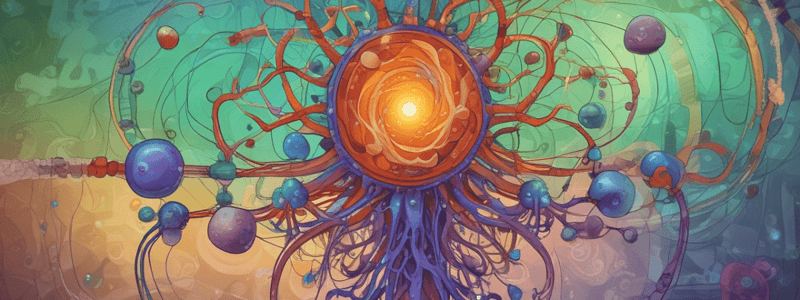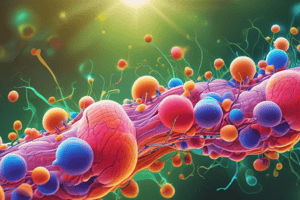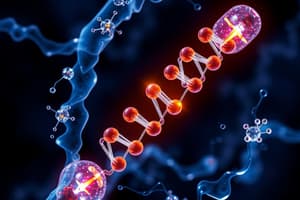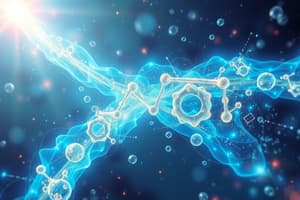Podcast
Questions and Answers
What is the primary function of Crassulacean acid metabolism (CAM) in plants?
What is the primary function of Crassulacean acid metabolism (CAM) in plants?
- To release carbon dioxide during the daytime
- To increase water loss during the daytime
- To trap carbon dioxide within leaves during the night (correct)
- To produce carbohydrates during the nighttime
Why do CAM plants open their stomata at night?
Why do CAM plants open their stomata at night?
- To reduce water loss during the night
- To increase photosynthesis during the night
- To allow CO2 to enter the leaf during the night (correct)
- To release oxygen during the night
What is the unit of energy used to measure the energy stored in food?
What is the unit of energy used to measure the energy stored in food?
- Calorie (correct)
- Watt
- Joule
- Kilocalorie
Why do organisms need to obtain energy from food?
Why do organisms need to obtain energy from food?
What is the difference between a calorie and a Calorie?
What is the difference between a calorie and a Calorie?
What is the primary purpose of cellular respiration?
What is the primary purpose of cellular respiration?
What type of plants are most likely to have Crassulacean acid metabolism (CAM)?
What type of plants are most likely to have Crassulacean acid metabolism (CAM)?
During the daytime, what happens to the organic acids produced in CAM plants?
During the daytime, what happens to the organic acids produced in CAM plants?
What is the primary function of ATP in cells?
What is the primary function of ATP in cells?
What is the role of electron carriers in photosynthesis?
What is the role of electron carriers in photosynthesis?
What is the by-product of light dependent reactions in photosynthesis?
What is the by-product of light dependent reactions in photosynthesis?
What is the name of the enzyme that combines CO2 molecules with 5-carbon compounds in the Calvin cycle?
What is the name of the enzyme that combines CO2 molecules with 5-carbon compounds in the Calvin cycle?
What is the term for the process of using energy from sunlight to synthesize high energy sugars from carbon dioxide and water?
What is the term for the process of using energy from sunlight to synthesize high energy sugars from carbon dioxide and water?
What is the name of the pigment that absorbs light energy in photosynthesis?
What is the name of the pigment that absorbs light energy in photosynthesis?
What is the name of the organelle where photosynthesis takes place?
What is the name of the organelle where photosynthesis takes place?
What is the term for the process of generating ATP and NADPH from light energy in photosynthesis?
What is the term for the process of generating ATP and NADPH from light energy in photosynthesis?
What is the factor that can limit the rate of photosynthesis in plants?
What is the factor that can limit the rate of photosynthesis in plants?
What is the term for the adaptation of plants to conserve water in hot conditions?
What is the term for the adaptation of plants to conserve water in hot conditions?
What is the primary function of cellular respiration?
What is the primary function of cellular respiration?
Which stage of cellular respiration does not require oxygen?
Which stage of cellular respiration does not require oxygen?
What is the net gain of ATP molecules during glycolysis?
What is the net gain of ATP molecules during glycolysis?
What is the byproduct of the Krebs cycle?
What is the byproduct of the Krebs cycle?
What is the role of NADPH in cellular respiration?
What is the role of NADPH in cellular respiration?
What is the difference between photosynthesis and cellular respiration?
What is the difference between photosynthesis and cellular respiration?
What is the energy yield of glycolysis?
What is the energy yield of glycolysis?
Where do the Krebs cycle and electron transport chain take place?
Where do the Krebs cycle and electron transport chain take place?
What is the purpose of fermentation?
What is the purpose of fermentation?
What is the energy source for cellular respiration?
What is the energy source for cellular respiration?
What is the primary function of the electron transport chain in cellular respiration?
What is the primary function of the electron transport chain in cellular respiration?
What is the net gain of ATP molecules during glycolysis?
What is the net gain of ATP molecules during glycolysis?
In which part of the mitochondrion is the electron transport chain located?
In which part of the mitochondrion is the electron transport chain located?
What is the purpose of chemiosmosis in cellular respiration?
What is the purpose of chemiosmosis in cellular respiration?
What is the byproduct of lactic acid fermentation in muscle cells?
What is the byproduct of lactic acid fermentation in muscle cells?
What is the primary source of energy for short, quick bursts of activity?
What is the primary source of energy for short, quick bursts of activity?
What is the purpose of the ATP synthase enzyme in chemiosmosis?
What is the purpose of the ATP synthase enzyme in chemiosmosis?
What is the result of the electron transport chain in the presence of oxygen?
What is the result of the electron transport chain in the presence of oxygen?
What is the purpose of the Krebs cycle in cellular respiration?
What is the purpose of the Krebs cycle in cellular respiration?
What is the primary source of energy for long-distance events?
What is the primary source of energy for long-distance events?
Flashcards are hidden until you start studying
Study Notes
Energy and Life
- Chemical energy and ATP:
- ATP (Adenosine Triphosphate) consists of adenine, a 5-carbon sugar called ribose, and three phosphate groups
- The three phosphate groups are key to ATP's ability to store and release energy
- ADP (Adenosine Diphosphate) is similar to ATP, but with only two phosphate groups
- Storing energy:
- All living things store energy in chemical bonds of certain compounds
- When cells have excess energy, they can store small amounts of it by adding phosphate groups to ADP to produce ATP
- Releasing energy:
- Cells release energy stored in ATP by breaking the chemical bonds between the second and third phosphate groups
- ATP functions like a rechargeable battery, with energy being used to add phosphate groups to ADP and released when a phosphate group is split off
- How cells use ATP:
- ATP is used for active transport, such as pumping sodium ions out of cells and potassium ions into them
- ATP is used to power cellular processes, such as protein synthesis and responses to chemical signals
- Most cells have a small amount of ATP, which is not suitable for long-term energy storage
Heterotrophs and Autotrophs
- Heterotrophs:
- Obtain food by consuming other living things
- May eat plants or other animals, or obtain food from decomposing organisms
- Autotrophs:
- Obtain energy from the sun
- Convert light energy into chemical energy through photosynthesis
- Produce high-energy carbohydrates, such as sugars and starches, that can be used as food
Photosynthesis
- Overview:
- Photosynthesis uses energy from sunlight to convert water and carbon dioxide into high-energy sugars and oxygen
- Plants use these sugars to produce complex carbohydrates, such as starches, and to provide energy for the synthesis of other compounds
- Light-dependent reactions:
- Take place in thylakoid membranes and use energy from sunlight to add a phosphate group to ADP to make ATP
- Use energy from sunlight to raise low-energy electrons from water molecules to a higher energy level
- Produce ATP and NADPH
- Light-independent reactions:
- Also known as the Calvin cycle
- Take place outside the thylakoids in the stroma of the chloroplast
- Use ATP and NADPH produced in the light-dependent reactions to build high-energy sugars from carbon dioxide
- Process of photosynthesis:
- Light-dependent reactions: generating ATP and NADPH
- ATP and NADPH are used to synthesize high-energy sugars
- Carbon dioxide enters the Calvin cycle, where it is converted into 3-carbon compounds
- These compounds are used to produce glucose and other high-energy sugars
Factors Affecting Photosynthesis
- Temperature:
- Photosynthesis is possible between 0°C and 35°C
- Light:
- High light intensity increases the rate of photosynthesis
- Plants can reach a maximum rate of photosynthesis at high light intensities
- Water:
- Water shortage can slow or stop photosynthesis
- Water loss can also damage plant tissues
- Photosynthesis under extreme conditions:
- C4 plants: have a specialized chemical pathway that allows them to capture low levels of CO2 and pass it to the Calvin cycle
- CAM plants: have adaptations to conserve water and survive in hot conditions### CAM Plants
- CAM plants (e.g. pineapple, desert cacti, fleshy "ice plant") have Crassulacean acid metabolism (CAM) photosynthesis
- During photosynthesis, CO2 is incorporated into organic acids at night
- At night, CO2 is combined with existing molecules to produce organic acids, "trapping" carbon within leaves
- During the day, these compounds release carbon dioxide inside the leaf, enabling carbohydrate production
Cellular Respiration: Overview
- Chemical energy from food is expressed in units of calories (1 calorie = energy needed to raise 1 gram of water 1°C)
- Cells use different molecules for food (e.g. fats, proteins, carbohydrates), with varying energy storage due to different chemical structures
- Cellular respiration is the process of energy conversion that releases energy from food in the presence of oxygen
- The overall equation for cellular respiration is: C6H12O6 + 6O2 → 6CO2 + 6H2O + Chemical Energy (in ATP)
Stages of Cellular Respiration
- Three main stages: glycolysis, Krebs cycle, and electron transport chain
- Glycolysis:
- 10% of glucose energy is captured to produce ATP
- At the end of glycolysis, 90% of chemical energy is still unused
- Krebs cycle:
- More energy is captured
- Electron transport chain:
- Requires reactants from other two stages
- Extracts energy using oxygen
Oxygen and Energy
- Oxygen is required at the end of the electron transport chain
- When cell demand for energy increases, oxygen use also increases
- Most energy-releasing pathways within cells require oxygen, which is why we need to breathe/respire
Pathways of Cellular Respiration
- Aerobic pathways (require oxygen): Krebs cycle and electron transport chain
- Anaerobic pathways (do not require oxygen): glycolysis and fermentation
- Glycolysis occurs in the cytoplasm, while Krebs cycle and electron transport chain occur in mitochondria
Comparing Photosynthesis and Cellular Respiration
- Cellular respiration is balanced by photosynthesis
- Their energy flows take place in opposite directions
- Photosynthesis "deposits" energy, while cellular respiration "withdraws" energy
- Photosynthesis uses water and CO2 to synthesize carbohydrates, while cellular respiration uses carbohydrates as a source of chemical energy and releases water and CO2
Glycolysis
- 1 molecule of glucose is transformed into 2 molecules of pyruvic acid
- As bonds in glucose are broken and rearranged, small amounts of energy are released and captured in other molecules
- ATP production: 2 ATP molecules are used to start glycolysis, and 4 ATP molecules are produced, resulting in a net gain of 2 ATP molecules
- NADPH production: 4 electrons are removed from glycolysis and passed to NAD+, which becomes NADPH, holding the electrons until they can be transferred to other molecules
Krebs Cycle
-
Pyruvic acid is broken down into carbon dioxide in a series of energy-extracting reactions
-
Citric acid production: pyruvic acid is converted into acetyl-CoA, which is then joined to a 4-carbon molecule to form citric acid
-
Energy extraction: 2 carbon atoms are removed from citric acid, releasing 2 molecules of carbon dioxide and leaving a 4-carbon molecule
-
For each turn of the cycle, 1 molecule of ADP is converted to 1 molecule of ATP, and 2 ATP molecules are produced for each starting molecule of glucose### ATP Molecules and Cellular Activities
-
ATP molecules are useful and become immediately available to power cellular activities.
-
In the presence of oxygen, electrons from carrier molecules are used to generate huge amounts of ATP.
Electron Transport and ATP Synthesis
- The electron transport chain uses high energy electrons from glycolysis and the Krebs cycle to synthesize ATP from ADP.
- NADH and FADH2 pass their high energy electrons to the electron transport chain.
- In eukaryotes, the electron transport chain is composed of a series of electron carriers located in the inner membrane of the mitochondrion.
- In prokaryotes, the same chain is in the cell membrane.
- High energy electrons are passed from carrier to carrier, and at the end of the chain, an enzyme combines these electrons with hydrogen ions and oxygen to form water.
- Oxygen is the final electron acceptor of the chain, which is why electron transport is aerobic.
ATP Production
- Cells use a process called chemiosmosis to produce ATP.
- The inner mitochondrial membrane contains enzymes known as ATP synthases.
- The charge difference across the membrane forces hydrogen ions through channels in these enzymes, causing the ATP synthases to spin.
- With each rotation, the enzyme grabs an ADP molecule and attaches a phosphate group, producing ATP.
- On average, each pair of high energy electrons that moves down the full length of the chain provides enough energy to produce 3 molecules of ATP.
The Totals
- Glycolysis nets just 2 ATP molecules per molecule of glucose.
- Together, glycolysis, Krebs, and the chain release about 36 molecules of ATP per molecule of glucose.
Fermentation
- When oxygen isn't present, glycolysis is kept going by a pathway that makes it possible to continue to produce ATP without oxygen.
- The combined process of this pathway and glycolysis is called fermentation.
- In the absence of oxygen, fermentation releases energy from food molecules by producing ATP.
- Cells convert NADH to NAD+ by passing high energy electrons back to pyruvic acid.
- Fermentation is an anaerobic process that occurs in the cytoplasm.
Alcoholic Fermentation
- Carried out by yeast, producing ethyl alcohol and carbon dioxide.
- Pyruvic acid + NADH → alcohol + CO2 + NAD+.
Lactic Acid Fermentation
- Chemical reaction that converts pyruvic acid to lactic acid.
- Does not give off CO2.
- Regenerates NAD+ so that glycolysis can continue.
- Pyruvic acid + NADH → Lactic acid + NAD+.
- Humans are also lactic acid fermenters.
Energy and Exercise
- During brief periods without enough oxygen, many of the cells in our bodies produce ATP by lactic acid fermentation.
- Muscle cells are best adapted to doing that.
- They need very large supplies of ATP for rapid bursts of activity.
- As swimmers begin a race, they only have enough ATP in their muscle cells to power them for a few seconds.
- To keep going, they must immediately generate new ATPs by cellular respiration or by lactic acid fermentation.
- Quick energy is produced by lactic acid fermentation, which does not involve the Krebs cycle, electron transport chain, or oxygen, resulting in it working more rapidly.
- This process produces lactic acid as a byproduct, which quickly builds up in muscles and the bloodstream of athletes.
- When the race is over, the only way to get rid of lactic acid is by means of another chemical pathway that requires extra oxygen.
- For that reason, you can think of a quick sprint as building up an “oxygen debt” that the swimmers have to repay with heavy breathing after the race.
Long-term Energy
- For exercise longer than 90 seconds, cellular respiration is the only way to continue generating a supply of ATP.
- Cellular respiration releases energy more slowly than fermentation.
- The body stores energy in muscle cells and other tissues in the form of carbohydrate glycogen.
- These stores are usually enough to last for 15-20 minutes of activity.
- After that, the body begins to break down other stored molecules, including fats, for energy.
- One reason that aerobic forms of exercise are beneficial for weight control.
- Athletes competing in long-distance events depend upon the efficiency of their respiratory and circulatory systems to supply oxygen to their muscles to support aerobic respiration.
Studying That Suits You
Use AI to generate personalized quizzes and flashcards to suit your learning preferences.




